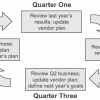Business Transformation Requires Transformational Leaders
Leadership and teaming skills are front and center in times of rapid change. Meet today’s constant disruption head on with expert guidance in leadership, business strategy, transformation, and innovation. Whether the disruption du jour is a digitally-driven upending of traditional business models, the pandemic-driven end to business as usual, or the change-driven challenge of staffing that meets your transformation plans—you’ll be prepared with cutting edge techniques and expert knowledge that enable strategic leadership.
Recently Published
In this issue of Cutter Benchmark Review, we focus on the corporate applications of wireless networking. We chose this topic because we seem to be on the threshold of wireless networking moving from being an interesting new development with some potential, to it becoming a staple technology of modern organizations. More importantly, while much of the current focus is on wireless as the backbone of communication introduced to create efficiencies, it may be time to think about how to use the wireless and mobile infrastructure to build innovative applications.
Vendor Business Planning: Maximizing Your Vendor ROI
How do you measure your vendors' performance? On-time delivery? Reject rate? Lowest product cost? Quality of service? These are all important metrics; however, they may not provide you with sufficient information to determine the adequacy of your return on the investment you made with your vendors. Such metrics tend to focus on the tactical attributes of the relationship but don't necessarily help evaluate the broader strategic attributes.
Wireless networking at the local, campus, and global levels continues to expand at a rapid pace. Cutter's survey on wireless networking shows that approximately two-thirds of participating organizations are currently supporting or utilizing wireless networks, such as Wi-Fi, for corporate applications (see Graph 20 in the Survey Data section).
The Human Side of E-Enterprise
As the monitoring and measuring capabilities initially designed for data mining literally move to the shop floor in business performance management, it is important to remember that human beings are at the core of any performance management process. While technology can be put into place to measure ongoing processes, determine where processes need to be improved, and observe shortfalls in the processes, at the end of the day, it is the changes in human behavior that make all the difference.
In this issue of Cutter Benchmark Review, we focus on the corporate applications of wireless networking. We chose this topic because we seem to be on the threshold of wireless networking moving from being an interesting new development with some potential, to it becoming a staple technology of modern organizations. More importantly, while much of the current focus is on wireless as the backbone of communication introduced to create efficiencies, it may be time to think about how to use the wireless and mobile infrastructure to build innovative applications.
In this issue of CBR, we focus on the corporate uses and applications of wireless networking. Wi-Fi (adopted by 67% of our respondents), BlackBerries, and cellular data connectivity (adopted by over 40% of our respondents) are now a staple in many organizations; and with the emergence of WiMAX networks and laptops with embedded 3G connectivity on the horizon, organizations are starting to approach wireless networking more strategically and systematically.
This survey examined the adoption and use of wireless networking technology in 82 organizations, 45% of which are headquartered in North America; of the remainder, 26% are headquartered in Europe, 13% in Asia, 12% in Australia/Pacific, and 4% in South America or Africa. Twenty-six percent of responding organizations have annual revenues of more than US $1 billion, 16% have annual revenues between $100 million and $1 billion, 22% have annual revenues between $10 million and $100 million, and 36% have annual revenues less than $10 million.
At the heart of customer relationship management (CRM) is the customer, and knowing the customer is key. Next month you’ll learn why it's vital to determine not just the customer’s propensity to buy but her capacity to buy — and why companies whose CRM systems leverage broader market data and predictive analytics will surpass those that get their CRM functionality out of a box.







